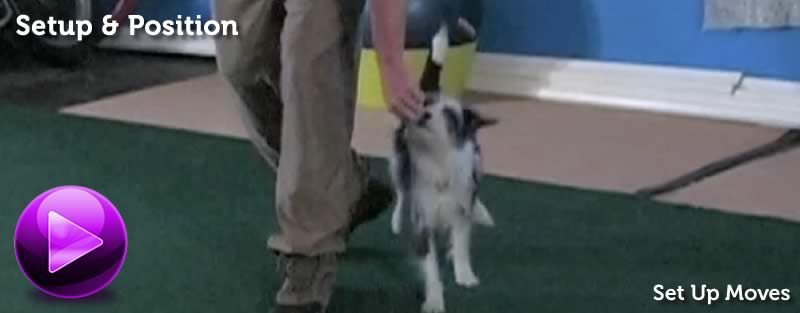
Disc Dog Set Up Moves
Set Up Moves Set Up Moves are tricks that are used to establish timing and position in disc dog freestyle. Traditional tricks include: Around, Through, Backwards Through, and Scoot, but any or all of your tricks,... More are the cool things we do to get our disc dogs into position. Go AroundAn Around, or a Go Around is the traditional disc dog set up move. The dog goes around the handler’s body in a clockwise or counter clockwise fashion allowing dog and handler to... More, between the legs, spin
Set Up Moves are tricks that are used to establish timing and position in disc dog freestyle. Traditional tricks include: Around, Through, Backwards Through, and Scoot, but any or all of your tricks,... More are the cool things we do to get our disc dogs into position. Go AroundAn Around, or a Go Around is the traditional disc dog set up move. The dog goes around the handler’s body in a clockwise or counter clockwise fashion allowing dog and handler to... More, between the legs, spin Spins and Twists are tricks where the dog spins 360 degrees in a clockwise or counter clockwise fashion. Spin is clockwise and Twist is counter clockwise so it is important to have a... More, scoot, etc. are all Set Up Moves. You can watch any top shelf disc dog competitor and note their mastery of Setting Up a dog. You also can watch them and see repetitive or default Set Up Moves that dictate the possibilities of the game. Some people Love to scoot! Some people just bring the dog in straight to the Front
Spins and Twists are tricks where the dog spins 360 degrees in a clockwise or counter clockwise fashion. Spin is clockwise and Twist is counter clockwise so it is important to have a... More, scoot, etc. are all Set Up Moves. You can watch any top shelf disc dog competitor and note their mastery of Setting Up a dog. You also can watch them and see repetitive or default Set Up Moves that dictate the possibilities of the game. Some people Love to scoot! Some people just bring the dog in straight to the Front Front is a stable position directly in front of the handler. Front is an traditional obedience skill. Usually your dog sits in this position, but standing is often acceptable as well, especially in... More of the handler.
Front is a stable position directly in front of the handler. Front is an traditional obedience skill. Usually your dog sits in this position, but standing is often acceptable as well, especially in... More of the handler.
At Pawsitive Vybe we work on being as flexible as possible when it comes to getting our dogs set up so the team looks cool while prepping for the next set of tricks. We also like to be able to create innovative and complex tricks involving unexpected movements and nifty angles. It’s far better to be able to do 10 set up moves than 3.
The video above demonstrates our Set Up Move Drill. It’s a five minute (Max!) session and teaches:
- Go Around – Clockwise and Counter Clockwise
- Through
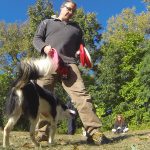 A Through is a set up move where the dog runs between the handler’s legs. The dog can move from front to back or side to side and can even weave. A Through... More – Go Through handler’s legs from front to back
A Through is a set up move where the dog runs between the handler’s legs. The dog can move from front to back or side to side and can even weave. A Through... More – Go Through handler’s legs from front to back - Backwards Through
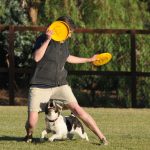 If your dog moves through your legs from back to front, that is a backwards Through. The Backwards Through usually sets up in one of two ways depending on where your dog’s starting... More – Go Through handler’s legs from Back to Front
If your dog moves through your legs from back to front, that is a backwards Through. The Backwards Through usually sets up in one of two ways depending on where your dog’s starting... More – Go Through handler’s legs from Back to Front - Scoot
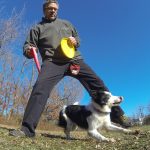 A Scoot is a Set Up Move where the dog scoots backwards between the handler’s legs. It’s a really clever Set Up Move, the image of your dog spinning around and shimmying backwards... More – Back Up Between Handler’s Legs from Back to Front
A Scoot is a Set Up Move where the dog scoots backwards between the handler’s legs. It’s a really clever Set Up Move, the image of your dog spinning around and shimmying backwards... More – Back Up Between Handler’s Legs from Back to Front
Each of those moves has a clockwise and counter clockwise variation, which means that this drill can teach 8 set up moves in 5 minutes. It’s one of our most important and valuable foundational drill. It is also one of the most efficient. Three 5 minute sessions and you teach all your set up moves that easily transfer to discs.





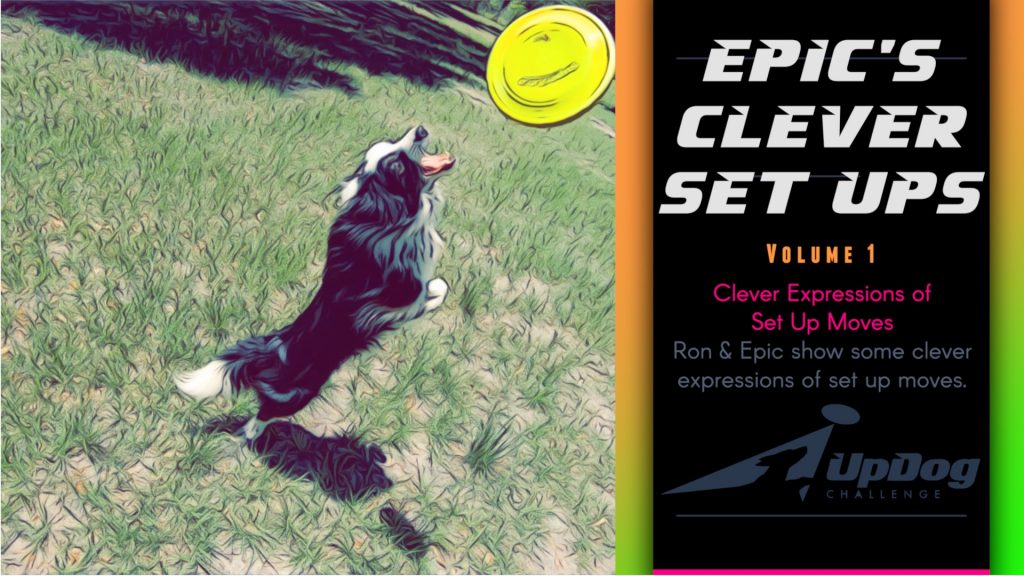
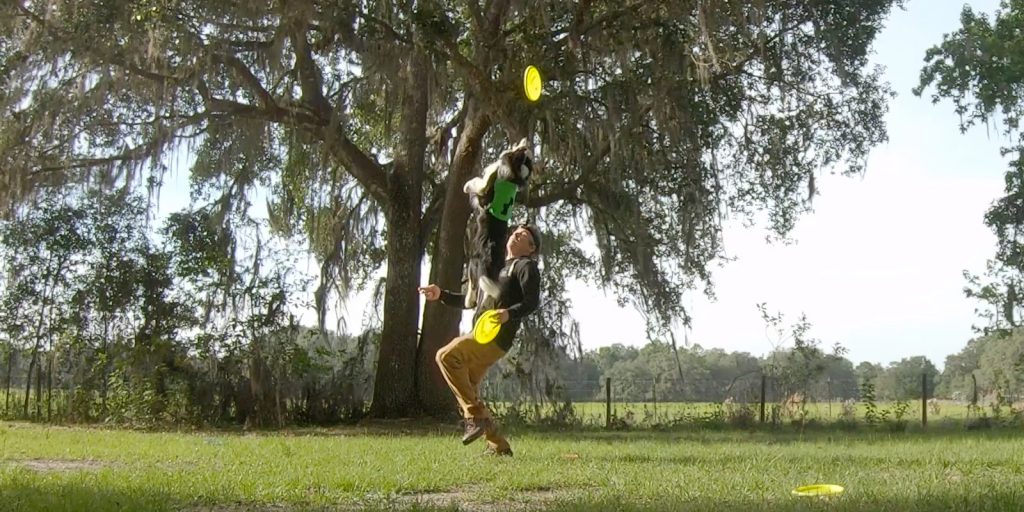
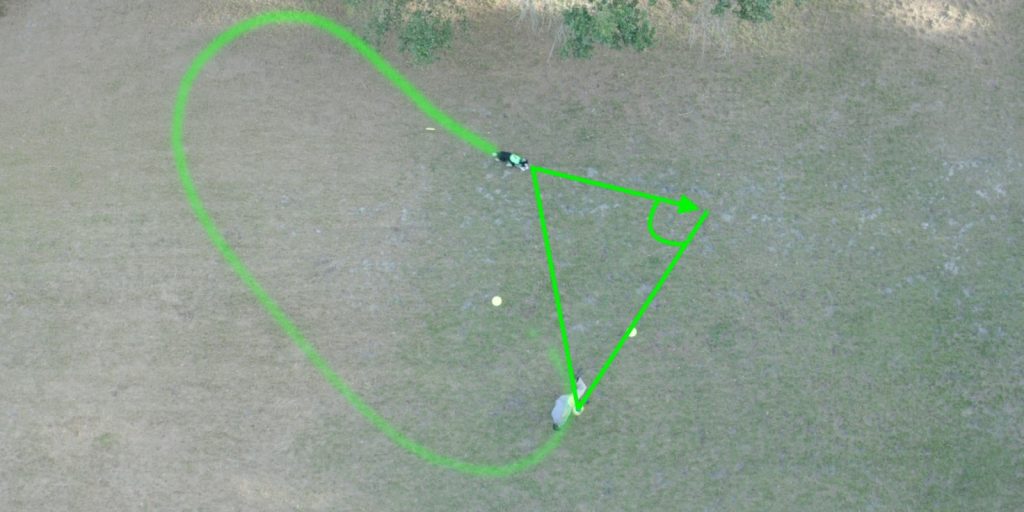
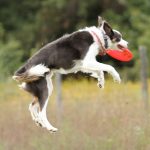
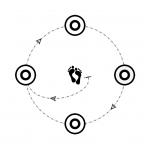
Nice video work. Love the close ups and multiple angles.
Thanks for noticing… these were shot a long time ago, almost 1 year old. Hard to believe that it’s been that long.
It shows in your recent videos of Hops
The cookie is an important part with these moves. What do you use for a cookie, do you chop up bait or do you use, say a kibble form the dogs dry food. And can we retrain or revisit these moves.
Yes, the cookie is important. Using cookies for this (and other) foundational drills is nice because we can get calm, methodical work instead of flying around trying to snag frisbees. We want to deliver information, and the signal to noise ratio is much better with cookies than discs.
A cookie is yummy food, it can be chopped up bait, kibble, whatever you need. I like to use yummy food to teach the skills initially, and then back off to kibble – our dogs here on the farm get lots of kibble for work. Once we get through our three 5 minute sessions, we can start the transition to discs.
Make sense?
Peace
You can retrain and revisit these moves, no problem. You might wind up with a light bulb clicking for them on set up moves that were weak.
Ron – video question… The first three videos in this lesson loaded up quickly. However, the flatwork demo and the Spooky Jams were really slow (thus very frustrating). Are they higher res or HD? I didn’t watch most of the Spooky jams because they took so long to load.
Hey Ann,
The Flatwork Demo and some of the spookyjam videos were HD. I will keep that in mind for the future. The flatwork demo and spookyjam videos can be downloaded though and are on iTunes which is pretty nice.
As far as the instructional video, they are SD only.
Thanks for letting us know.
Peace,
Ron
Thanks Ron. The iTunes option is nice. My vote though is to keep with SD for most of the stuff. the quality is pretty good and it’s a lot less frustrating.
Loved the week 1 videos and blogs. Before this we were really struggling with ‘around’ but I feel confident we’ll get it now. Chance is even occasionally bringing a disc all the way back too. I think the dismissal work is paying off.
Hi Ron
I signed up for the Premier course. I just finish listening to the first conference call and that really sounds worthwhile. I’d like to be in on the next one. I’m not sure how to go about it. I have never used Talkshoe. I noticed most callers called in from a land line, which might not be too practical from here in Australia. I might have to use Skype, will that work with Talkshoe? Also, with the video part of course you mentioned to use bliptv or Youtube. I have not used either, good time to start! Is bliptv not as public as Youtube and do they cost anything? I have a Sony DV tape camera. I have put video on my PC. Do I need to convert the footage in order to upload to either service? Any advice would be helpful.
Thanks
G’day Jeff, Brodie and Maddison “the new puppy”
I think Skype will work, Jeff.
You also can hook up with me on Skype – k9disc is my username. That goes for the rest of you as well. Get skype set up on your computer for group chat.
Give blip a try for your video.
Peace
I noticed that you mark the transfer of food but do not necessarily feed after every time you mark. Sometimes yes means cookie and sometimes yes means follow another lure. Are you counting access to a moving lure as a reward too as well as eating the lure? With my own dog I usually use good as a duration marker when I’m not feeding/rewarding (so I would use it to mark the transfer) and yes as a reward marker. Do you think it makes difference?
My dog already knows some of these moves but I taught them with shaping. Do you think I need to go back and do a few times with a lure? Do the hand gestures eventually become cues as you hold the frisbee or will you eventually put these behaviors on verbal cue?
Excellent Question, Sara!
There’s a book to be written on this… lol. Marion, and anybody else not interested in deep Positive Dog Training philosophy and terminology, quick close your eyes!!! 😉
You are correct in your observation and I am using the lure as a reward too. I call it Rewarding with Chase.
One major part of Pawsitive Vybe’s philosophy is that dog’s don’t earn a cookie, they earn the opportunity for a cookie. A part of this opportunity concept is the idea that not every mark equals a cookie. Not every click equals a cookie.
We mark all correct behaviors that we as handlers are seeking and reward variably. We call this variable reinforcement.
This is quite different from the Bob Bailey school of marker training (probably the more popular school) where every mark (click) equals a cookie. When the dog performs the target behavior and gets no feedback from the handler, then on the next rep gets marked and given reinforcement, we consider that to be variable marking of behavior.
As a matter of fact, one of the greatest schisms we have in positive dog training is variable reinforcement vs variable marking.
I know that it makes a difference, because I can tell when a dog has been trained with your style, but it’s a matter of handler preference and proficiency. If it’s working for you, keep it up.
Back to the topic at hand…
You will be fine using your lower value mark, when you are not going to be paying, absolutely no problem.
I would recommend luring for this skill especially if it’s already been taught through shaping.
There’s a lot of baggage that goes along with shaping – superstitious behavior, lack of intensity and speed, and the freedom to create. Not exactly what we’re looking for in the foundation of the application of our game.
I’m not dumping on shaping, by the way, these behaviors can be shaped to every bit the performance level of my dogs, no problem, but I believe that some quality luring and leadership from the handler can really define the skill and set the muscle memory so the dog has clarity on exactly what that behavior is.
Also, there is the idea that we are setting a cuing system with this drill. It deals with transferring targets from hand to hand. Each of these foundational drills have a common thread – watch the hands (and shoulders) and learn to look for and take those cues. This transferring of targets that we are putting on the dogs at a very base level with the passing of the cookie and the matching of the hands will transfer to the matching of the discs. We can suggest motion with a disc in one hand and transfer that motion to the disc in the other hand.
We also do put these on a verbal cue. Verbal cue, then the hand signal or positional cue.
Make sense?
Absolutely stellar question, Sara. Thanks!
How long do you mark the transfer for? Just till the dog understands transferring of different targets?
Cindy
Pretty much Cindy.
It is important though that it is marked and drawn attention to.
And keep in mind here at Pawsitive Vybe a dog would only go through this drill 4 or 5 times with treats, max. Same with discs.
It’s very rapid and efficient learning if it’s done properly.
Hi Ron,
For go around clockwise and counter clockwise do you use verbal cues or is better to signal by hand/body position? Personally I don’t use verbal cue (with Blue) but still being here and (re)luring around i think is a good opportunity to insert these cues if you recommend.
Thanks, Bruno
I use a verbal and think it’s a good idea.
I give a verbal then a hand or positional cue.
Wait a while on Cuing it. You definitely don’t want to try to put it on cue while working this drill. You’ll want to generalize it to toys and discs and have the moves solid before cuing it.
Peace
Hi Ron,
I did have to almost close my eyes reading your long reply to Sara’s post *laugh* but honestly I don’t understand much of the dog lingo so I blink a few times re-read a few more then go search words I don’t get on google *grin*
My question for the moment is when naming the moves that are the same moves but done from each side or in different directions do we use the same word/cue for them like the around? Or do we call one way “around” and call the other way around something else? Like we do for spin & twist or heal & side?
I am slightly tired so I hope I am making sense.
Marion
Makes total sense, Marion.
As to your question:
We will name each move separately. Here are my set up move verbal cues:
Around Clockwise: Makai
Around Counter: Mauka
Through: through – only one of those, and I can tell you why if you want to know.
Backwards Through: Rut – through backwards… please don’t laugh…
Scoot: scoot from front
Get Back: scoot from side or heel
We are not going to start verbally cuing them until they are able to be performed successfully. When you can bet $100 that it is going to happen, correctly, the moment you cue it, then you can verbally cue it.
Peace
Thanks for the reply- makes sense to me at least 🙂
Sara
Thanks Ron, that saves a lot of confusion down the road.
I am sure that I will leave rut out of my verbal cue..Just incase I am misunderstood somewhere along the line when playing out in public *laugh*..
Marion
Hi Ron,
On the set-up moves drill my inexperienced dog is doing something that I just wanted to make sure I was handling correctly. During the drills she is starting to anticipate where the finish is and by-passes the match. When she does this I don’t mark and just start the exercise over. Is that the right thing to do?
Thanks,
Shana
It shouldn’t be a problem, Shana, as long as you initially laid the foundation tight and clean with the focus on the match.
The dogs will tell us when it’s time to add a toy. Perhaps it’s that time…
Here is the video of me doing our setup moves drill…be kind! (also someone let me know if this link doesn’t work)
Thanks,
Shana
http://albums.phanfare.com/isolated/t17eQR90/1/4902400
Thanks for posting it here, Shana. I’ll take another look at it…
So we have been working on these moves but are still having some problems with the match. I am marking it every time but Ember is sometimes (1/10 times) backtracking and following the hand that just released the treat. I think its because she is trying to move too fast so I am trying to go slow and make her just follow the lure but she gets pretty excited to do anything working. We have that problem with anything I try to teach. Any tips would be appreciated.
I’m in the process of getting that video together, Lindsay. I’d guess that you have a twitch or something in your first hand. Or you’ve got something in your foundation that is causing a balk.
You can disengage and take a couple of seconds any time that happens. You should also revisit the Rewarding with Action blog entry.
Video coming soon.
Peace,
Ron
Lindsay,
The beginning of the Treat to Toy Transfer video covers what I was talking about.
The hand that passed the target kind of disappears and the hand that receives the passed target screams Look at me!. You can see where and when this happens on the video if you look for it. You can also see where the dog is confused between the two targets and goes for the wrong one because it moved or twitched or something.
Also notice how the mistakes were treated. There should be a consequent break in the game when she blows it. Unfortunately this isn’t be best illustration of that consequent break, as Layla was really reacting to the sounds of traffic that are getting pretty loud here as the leaves fall of the trees and the sound carries more, but you can still see the subtle, break in the game and/or ho hum response to her poor attempts on occasion.
I do think this video shows how to play with this skill. Perhaps that would help you out a bit, Lindsay – free her up a bit. This Comment to Sara on the
Treat to Toy Transfer lesson would be good to check out.
Peace